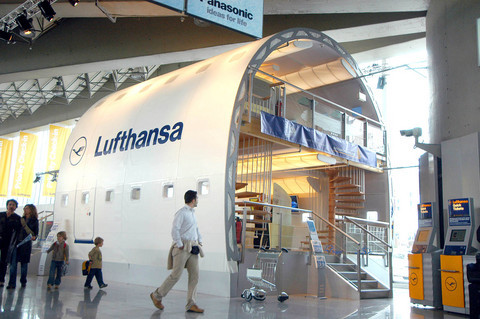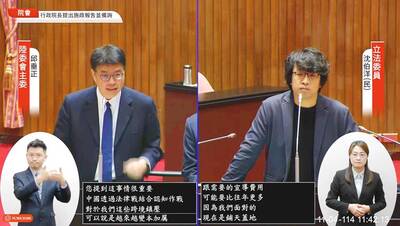Now that the Airbus A380 has taken to the skies on its first test flight, this giant bird needs someplace to land. For Airbus, selling its new superjumbo jet to the world's airports has been only slightly less strenuous than selling it to airlines.
Representatives of airports in Europe, Asia, and the US gathered here on Thursday, energized after Wednesday's smooth flight, to discuss how they are getting ready for the A380, which is scheduled to go into service in the middle of next year with Singapore Airlines.
But as the talk at the conference drifted to the costly, unglamorous business of reinforcing taxiways and retrofitting gates, some of the excitement faded. The A380, people here acknowledge, is going to be more of a burden, and a risk, for airports than Airbus likes to suggest.

PHOTO: NY TIMES
"What's going to happen when two of these planes arrive at the same time and dump 1,000 people into immigration and baggage claim?" said John Kasarda, an expert on airports and professor of business administration at the University of North Carolina.
Preparing for all these people, and buttressing runways for a plane that can weigh 544 tonnes on takeoff, is not cheap. It will cost airports an average of US$100 million to upgrade their facilities, according to industry studies. Heathrow Airport near London is spending US$857 million.
For Heathrow, one of the world's most congested fields, that heavy investment may pay off. By 2016, analysts estimate, the A380 could account for one of every eight flights there. That would increase Heathrow's capacity by nearly 10 million people without adding a single new flight.
But for airports that will attract only a handful of A380s, the arithmetic is more troubling. Among the busiest airports, Hartsfield-Jackson in Atlanta has said it plans no upgrades for the A380; O'Hare in Chicago has not yet decided. Only Kennedy, Los Angeles International, San Francisco International and Miami International among US airports are committed to the plane.
"What happens if you spend US$100 million, and your only airline with an A380 flight cancels it?" said Kasarda, who was chairman of the conference here. "This industry is turbulent and unforgiving."
Airbus, which is based in Toulouse, France, brushed aside such worries.
"Why would airports not want to adapt? They'll have to adapt," said Richard Carcaillet, the head of product marketing for the A380.
Carcaillet's confidence stems from what he describes as the A380s remarkably strong order book. Airbus has firm orders and commitments for 154 planes from 15 customers -- distributed among Europe, the Middle East, and Asia. But among American carriers, only FedEx and United Parcel Service have ordered A380s -- 10 freighters each.
Few people predict that major airports will not be ready for the A380. But there may be some close calls. Los Angeles International wants to move one of its four runways several feet to the south to create a center taxiway wide enough to be used by A380s after they land.
But the plans have been bogged down in litigation, and Los Angeles World Airports, the authority that runs the airport, is not sure it will finish construction before the first flight is expected there, in November next year. It says it has a backup plan: obtaining Federal Aviation Administration approval for the plane to land on one of the other runways.
The airport has had to compromise in other ways. Because space is at such a premium, it is converting only two gates at the Tom Bradley International Terminal to serve A380s. To compensate, it is setting up two other gates on the airfield away from the terminal.
"The airlines would prefer not to use these, but it gives us overflow capacity," Mark Massman, deputy executive director of Los Angeles World Airports, said in a telephone interview.
Virgin Atlantic Airways, one of the first buyers of the A380, has cited the restrictions in Los Angeles as one of the reasons it pushed back delivery of its six planes until early 2008.
Massman predicted that Los Angeles would nonetheless be a hub airport for the A380, because it is a gateway for travelers from Asia. But as to the A380s potential for easing congestion, one of the advantages cited by Airbus, he said it would be only a "minor improvement."
It may be little surprise that most American airports seem less enthusiastic about the A380 than their European counterparts. Airbus, after all, is a European pet project -- owned by its military contractors and backed by the leaders of France, the UK, Germany, and Spain.
US airports are limited by tight budgets and aging facilities. At Kennedy, for example, the Port Authority of New York and New Jersey is spending US$130 million on two mundane projects to accommodate the A380: reinforcing two bridges that carry planes over highways, and shifting a taxiway that rings the terminals. The authority estimates that the A380 will generate US$233 million a year in benefits for the region by 2016 in new jobs and other revenue.
Fraport, the company that owns Frankfurt airport, did not even mention costs in outlining its plan to build 12 A380 gates in two terminals. It also plans a cavernous maintenance building for Lufthansa's 15 super-jumbos. And Charles de Gaulle Airport north of Paris is building a satellite terminal with six A380 gates.
But the Europeans have nothing on the Persian Gulf emirate of Dubai. Its airline, Emirates, ordered 43 A380s, the largest single order, and the home airport is thinking big. Coming in 2008: a US$4.1 billion terminal, with two concourses able to handle 23 A380s. Passengers will board on both the lower and upper decks.
Dubai is not stopping there. Betting that 100 million passengers a year will pass through by 2020, it is building a second airport nearby. "We're building a special airport for the A380," said Rimzie Ismail, the marketing manager for Dubai's civil aviation department.

CALL FOR SUPPORT: President William Lai called on lawmakers across party lines to ensure the livelihood of Taiwanese and that national security is protected President William Lai (賴清德) yesterday called for bipartisan support for Taiwan’s investment in self-defense capabilities at the christening and launch of two coast guard vessels at CSBC Corp, Taiwan’s (台灣國際造船) shipyard in Kaohsiung. The Taipei (台北) is the fourth and final ship of the Chiayi-class offshore patrol vessels, and the Siraya (西拉雅) is the Coast Guard Administration’s (CGA) first-ever ocean patrol vessel, the government said. The Taipei is the fourth and final ship of the Chiayi-class offshore patrol vessels with a displacement of about 4,000 tonnes, Lai said. This ship class was ordered as a result of former president Tsai Ing-wen’s (蔡英文) 2018

‘SECRETS’: While saying China would not attack during his presidency, Donald Trump declined to say how Washington would respond if Beijing were to take military action US President Donald Trump said that China would not take military action against Taiwan while he is president, as the Chinese leaders “know the consequences.” Trump made the statement during an interview on CBS’ 60 Minutes program that aired on Sunday, a few days after his meeting with Chinese President Xi Jinping (習近平) in South Korea. “He [Xi] has openly said, and his people have openly said at meetings, ‘we would never do anything while President Trump is president,’ because they know the consequences,” Trump said in the interview. However, he repeatedly declined to say exactly how Washington would respond in

WARFARE: All sectors of society should recognize, unite, and collectively resist and condemn Beijing’s cross-border suppression, MAC Minister Chiu Chui-cheng said The number of Taiwanese detained because of legal affairs by Chinese authorities has tripled this year, as Beijing intensified its intimidation and division of Taiwanese by combining lawfare and cognitive warfare, the Mainland Affairs Council (MAC) said yesterday. MAC Minister Chiu Chui-cheng (邱垂正) made the statement in response to questions by Democratic Progressive Party (DPP) Legislator Puma Shen (沈柏洋) about the government’s response to counter Chinese public opinion warfare, lawfare and psychological warfare. Shen said he is also being investigated by China for promoting “Taiwanese independence.” He was referring to a report published on Tuesday last week by China’s state-run Xinhua news agency,

‘ADDITIONAL CONDITION’: Taiwan will work with like-minded countries to protect its right to participate in next year’s meeting, the foreign ministry said The US will “continue to press China for security arrangements and protocols that safeguard all participants when attending APEC meetings in China,” a US Department of State spokesperson said yesterday, after Beijing suggested that members must adhere to its “one China principle” to participate. “The United States insists on the full and equal participation of all APEC member economies — including Taiwan — consistent with APEC’s guidelines, rules and established practice, as affirmed by China in its offer to host in 2026,” the unnamed spokesperson said in response to media queries about China putting a “one China” principle condition on Taiwan’s